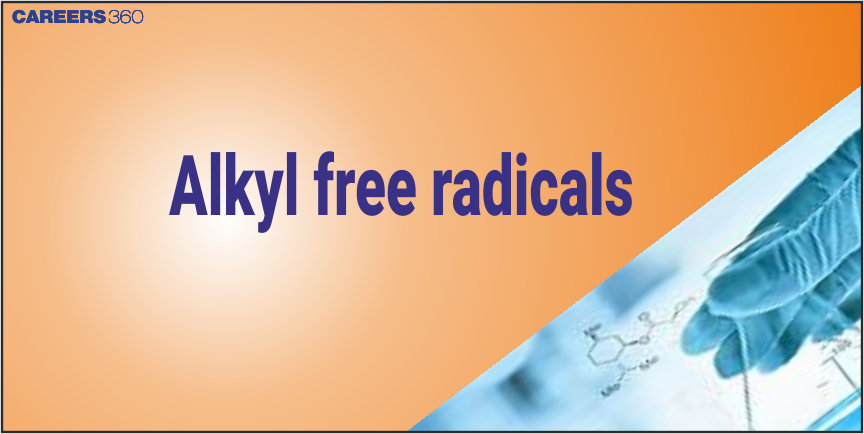Alkyl Free Radicals
Alkyl free radicals are highly reactive species that play a significant role in organic chemistry, particularly in reactions involving organic synthesis and combustion processes. An alkyl free radical is an organic molecule containing an alkyl group (a group derived from an alkane by removing one hydrogen atom) with an unpaired electron. The general structure of an alkyl radical is R⋅ where R, represents an alkyl group and (⋅)denotes the unpaired electron.
NEET 2025: Mock Test Series | Syllabus | High Scoring Topics | PYQs
JEE Main: Study Materials | High Scoring Topics | Preparation Guide
JEE Main: Syllabus | Sample Papers | Mock Tests | PYQs

In this article, we will cover the topic (Alkyl Free Radicals). This topic falls under the broader category of (Some Basic Principles of Organic Chemistry), which is a crucial chapter in (Class 11 Chemistry). It is not only essential for board exams but also for competitive exams like the Joint Entrance Examination (JEE Main), National Eligibility Entrance Test (NEET), and other entrance exams such as SRMJEE, BITSAT, WBJEE, BCECE, and more.
Alkyl Free Radicals
This is the case when the movement of a single electron takes place instead of an electron pair. Such cleavage results in the formation of neutral species (atom or group) which contains an unpaired electron. These species are called free radicals. Like carbocations and carbanions, free radicals are also very reactive. Alkyl radicals are classified as primary, secondary, or tertiary. Alkyl radical stability increases as we proceed from primary to tertiary:
$\dot{\mathrm{C}} \mathrm{H}_3$ $<\dot{\mathrm{C}} \mathrm{H}_2 \mathrm{CH}_3<$ $\dot{\mathrm{C}} \mathrm{H}\left(\mathrm{CH}_3\right)_2$ $<\dot{\mathrm{C}}\left(\mathrm{CH}_3\right)_3$
Recommended topic video on(Alkyl free radicals)
Solved Examples Based on Alkyl Free radicals
Q.1 The increasing order of stability of the following free radicals is-
$\begin{aligned} & \left.\text { (1) } \mathrm{CH}_3\right)_2 \mathrm{CH}<\left(\mathrm{CH}_3\right)_3 \mathrm{C}<\left(\mathrm{C}_6 \mathrm{H}_5\right)_2 \mathrm{CH}<\left(\mathrm{C}_6 \mathrm{H}_5\right)_3 \mathrm{C} \\ & \text { (2) }\left(\mathrm{C}_6 \mathrm{H}_5\right)_3 \mathrm{C}<\left(\mathrm{C}_6 \mathrm{H}_5\right)_2 \mathrm{CH}<\left(\mathrm{CH}_3\right)_3 \mathrm{C}<\left(\mathrm{CH}_3\right)_2 \mathrm{CH} \\ & \text { (3) }\left(\mathrm{C}_6 \mathrm{H}_5\right)_2 \mathrm{CH}<\left(\mathrm{C}_6 \mathrm{H}_5\right)_3 \mathrm{C}<\left(\mathrm{CH}_3\right)_3 \mathrm{C}<\left(\mathrm{CH}_3\right)_2 \mathrm{CH} \\ & \text { (4) }\left(\mathrm{CH}_3\right)_2 \mathrm{CH}<\left(\mathrm{CH}_3\right)_3 \mathrm{C}<\left(\mathrm{C}_6 \mathrm{H}_5\right)_3 \mathrm{C}<\left(\mathrm{C}_6 \mathrm{H}_5\right)_2 \mathrm{CH}\end{aligned}$
Solution:
As we learned-
Alkyl Free Radicals -
This is the case when the movement of a single electron takes place instead of an electron pair. Such cleavage results in the formation of neutral species (atom or group) which contains an unpaired electron. These species are called free radicals. Like carbocations and carbanions.
Free radicals are also very reactive. Alkyl radicals are classified as primary, secondary, or tertiary. Alkyl radical stability increases as we proceed from primary to tertiary:
Alkyl radical stability order:
primary < secondary < tertiary.
Stability of alkyl free radical -
The electron donating group stabilises alkyl free radicals and the withdrawing group destabilises alkyl free radicals.
Stability of alkyl free radical due to resonance -
The more the no resonating structure the greater the stability.
A free radical is stabilised due to resonance, hyperconjugation and inductive effect. In the given problem the order of stability of free radicals is-
$\left(\mathrm{CH}_3\right)_2 \dot{\mathrm{C} H}<\left(\mathrm{CH}_3\right)_3 \dot{\mathrm{C}}<\left(\mathrm{C}_6 \mathrm{H}_5\right)_2 \dot{\mathrm{C}} \mathrm{H}<\left(\mathrm{C}_6 \mathrm{H}_5\right)_3 \dot{C}$
Hence, the answer is the option (1).
Q.2 Which of the following statement is not true regarding a Carbon free radical?
(1) It is electrically neutral
(2) It is highly unstable and reactive
(3) It is short lived
(4) There are 6 electrons present in the valence shell on the carbon atom of the free radical
Solution:
As we learned-
Free radicals are chemical species that contain a single unpaired electron in an outer orbit.

It is electrically neutral because there are 7 electrons present in the valence shell on the carbon atom and does not have any extra or fewer electrons.
It is highly unstable and reactive because the octet is not completed.
It is short-lived because It is highly unstable and reactive.
There are 7 electrons present in the valence shell on the carbon atom of the free radical but in a statement, it is saying 6 electrons are present in the valence shell on the carbon atom of the free radical, which is not correct.
Hence, the answer is Option (4).
Conclusion
Free radicals: A highly reactive species with an unpaired electron, such as the alkyl free radical); carbocations; carbanions. Stability on this ion is more with higher degree of substitution (tertiary > secondary> primary) because of hyperconjugation and inductive effects Radicals are involved in many chemical reactions, e.g. radical addition polymerization; neutral is also used to form carbon-carbon bonds (hence the name of this growing class of organometallic complexes). They are exemplified by the methyl radical ⋅CH₃ and ethyl radical ⋅C₂H₅ This is important for controlling the behavior of chemicals in industrial and laboratory chemical reactions.
Also Read
11 Mar'25 05:47 PM
19 Feb'25 12:54 PM
18 Feb'25 11:58 PM
18 Feb'25 07:00 PM
18 Feb'25 06:11 PM
18 Feb'25 12:56 PM
18 Feb'25 12:33 PM
19 Oct'24 02:45 PM
19 Oct'24 12:48 PM
19 Oct'24 12:46 PM